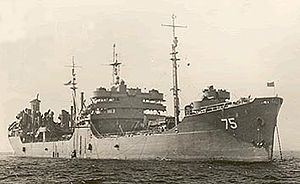USS Saugatuck (AO-75)
 |
|
| History | |
|---|---|
| Name: | USS Saugatuck |
| Builder: | Sun Shipbuilding & Drydock Co., Chester, Pennsylvania |
| Laid down: | 20 August 1942 |
| Launched: | 7 December 1942 |
| Commissioned: | 19 February 1943 |
| Decommissioned: | 29 March 1946 |
| In service: | 1948, as USNS Saugatuck (T-AOT-75) |
| Out of service: | 1974 |
| Renamed: | Saugatuck, 16 September 1942 |
| Honors and awards: |
7 battle stars (World War II) |
| Fate: | Sold for scrapping, 2006 |
| General characteristics | |
| Type: | Suamico-class fleet replenishment oiler |
| Displacement: |
|
| Length: | |
| Beam: | 67 ft 9 in (20.65 m) |
| Draft: | 30 ft 9 in (9.37 m) |
| Propulsion: |
|
| Speed: | 15 knots (28 km/h; 17 mph) |
| Range: | 13,000 nmi (24,000 km) at 15 kn (28 km/h; 17 mph) |
| Capacity: | 141,000 barrels (22,400 m3) |
| Complement: |
|
| Armament: |
|
USS Saugatuck (AO-75) was a Suamico-class replenishment oiler of the United States Navy.
The ship was laid down on 20 August 1942 as SS Newtown, a Maritime Commission type Type T2-SE-A1 tanker hull, under Maritime Commission contract (MC hull 355) at the Sun Shipbuilding & Drydock Co., Chester, Pennsylvania. She was renamed Saugatuck on 16 September 1942. Launched on 7 December 1942, and delivered to the U.S. Navy, she was converted for naval service at Bethlehem Steel Co., Key Highway Plant, Baltimore, Maryland. She was commissioned on 19 February 1943, with Lt. Comdr. Ben Koerner, USNR, in command. It was named for the Saugatuck River in Connecticut.
Following shakedown in Chesapeake Bay, Saugatuck departed Norfolk for the Netherlands West Indies and the Panama Canal. On 30 April, she transited the canal; and, the next day, headed for the South Pacific. Diverted en route, she was ordered first to Pearl Harbor, thence to San Pedro, California. During the summer and fall, she carried fuels and lubricants to Espiritu Santo and Funafuti. In December, she assumed duties as station oiler at Espiritu Santo. Late in January 1944, she put to sea to rendezvous with, and refuel, fleet units engaged in the Marshalls' campaign; and, by 5 February, she had begun fueling ships in Majuro Lagoon.
...
Wikipedia
